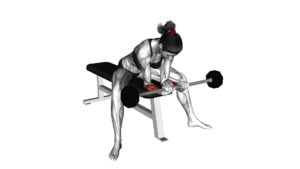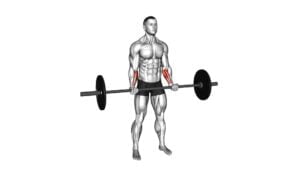Barbell Wrist Curl (female) – Video Exercise Guide & Tips

Are you a female looking to strengthen your wrists and improve your overall upper body strength? Then the barbell wrist curl is the perfect exercise for you.
Watch This Exercise Video
In this video exercise guide, we'll show you the proper form and technique to perform the barbell wrist curl effectively. We'll also provide variations and modifications specifically tailored for female athletes.
With our helpful tips, you'll be able to prevent wrist injuries and seamlessly incorporate the barbell wrist curl into your workout routine.
Key Takeaways
- Barbell wrist curls can improve grip strength for female athletes.
- This exercise can enhance performance in sports like weightlifting, gymnastics, rock climbing, and tennis.
- Barbell wrist curls can increase upper body strength and stability.
- Proper form and technique, along with gradual weight progression, are important to prevent injury and allow for progress.
Benefits of Barbell Wrist Curl for Females
One key benefit of incorporating barbell wrist curls into your workout routine is improved grip strength for females. Grip strength is important for female athletes as it can enhance their performance in various sports, such as weightlifting, gymnastics, rock climbing, and tennis. Having a strong grip allows female athletes to have better control over objects, maintain a firm hold, and prevent injuries that may occur due to weak grip.
In addition to its importance for female athletes, wrist strengthening exercises like barbell wrist curls offer numerous benefits for overall fitness. By targeting the muscles in the forearms and wrists, these exercises help to increase strength and stability in the upper body. This can have a positive impact on daily activities that involve gripping and lifting, such as carrying groceries, opening jars, or even holding your own body weight during exercises like push-ups or pull-ups.
Furthermore, strong wrists and forearms contribute to better posture and alignment, as they provide support to the hands and arms. This can improve performance in other exercises and reduce the risk of injuries to the wrists and elbows. By incorporating barbell wrist curls into your workout routine, you can enhance your grip strength, improve overall fitness, and minimize the chances of experiencing discomfort or injuries related to weak wrists and forearms.
Proper Form and Technique for Barbell Wrist Curl
To perform the barbell wrist curl with proper form and technique, start by gripping the barbell with an underhand grip and resting your forearms on a flat surface. Here are some tips to help you maintain proper form and avoid common mistakes:
- Keep your wrists straight: It's important to maintain a neutral wrist position throughout the exercise. Avoid bending your wrists or allowing them to collapse.
- Engage your forearm muscles: As you curl the barbell up towards your body, focus on contracting your forearm muscles. This will help to maximize the effectiveness of the exercise.
- Control the movement: Avoid using momentum to lift the weight. Instead, focus on controlled and deliberate movements, both on the way up and on the way down.
- Gradually increase the weight: Start with a lighter weight and gradually increase it as you become more comfortable and confident with the exercise. This will help to prevent injury and allow for steady progress.
To perform the barbell wrist curl, you'll need a barbell and a flat surface to rest your forearms on.
Now, let's move on to discussing variations and modifications for female athletes.
Variations and Modifications for Female Athletes
If you're a female athlete looking to modify or vary your barbell wrist curl exercise, you can try incorporating different grips and equipment. By using different grips, such as an overhand or underhand grip, you can target different muscles in your forearms and wrists. Additionally, you can use different equipment options to further modify the exercise. For example, you can use dumbbells instead of a barbell to perform the wrist curl exercise. This can provide a different challenge and help improve your wrist strength.
Wrist strength is crucial for female athletes as it plays a significant role in various sports and activities. Strong wrists can enhance your performance in activities that require grip strength, such as weightlifting, tennis, golf, and rock climbing. It can also help prevent injuries, as weak wrists are more prone to sprains and strains.
In the subsequent section about 'tips to prevent wrist injuries during barbell wrist curl', you'll learn about important techniques and precautions to keep your wrists safe during this exercise. By following these tips, you can minimize the risk of injuries and continue to strengthen your wrists effectively.
Tips to Prevent Wrist Injuries During Barbell Wrist Curl
To prevent wrist injuries during barbell wrist curl, ensure proper form by maintaining a neutral wrist position throughout the exercise. This will help distribute the weight evenly and decrease the risk of straining or injuring the wrists. Here are some additional tips to prevent wrist injuries during barbell wrist curl:
- Warm up: Before starting any exercise, it's important to warm up your wrists with gentle movements and stretches. This will increase blood flow to the area and prepare your wrists for the workout.
- Gradual progression: Start with lighter weights and gradually increase the load as your wrists get stronger. Pushing too hard too soon can lead to overuse injuries or strains.
- Use wrist wraps: Wrist wraps can provide additional support and stability to the wrists during barbell wrist curls. They help to keep the wrists aligned and reduce the risk of injury.
- Incorporate wrist strengthening exercises: Strengthening the muscles around the wrist can help improve stability and reduce the risk of injury. Include exercises like wrist curls, wrist extensions, and wrist rotations in your workout routine.
How to Incorporate Barbell Wrist Curl Into Your Workout Routine
To effectively incorporate barbell wrist curls into your workout routine, you can follow these simple steps.
First, start by adding wrist curls to your upper body workouts. This exercise specifically targets your forearms, helping to strengthen and tone them. Begin by holding a barbell with an underhand grip, keeping your wrists straight. Rest your forearms on a bench or your thighs, allowing your wrists to hang off the edge.
Slowly curl the barbell upward, contracting your forearms. Hold the position briefly and then lower the barbell back down to the starting position. Aim for three sets of 10-12 repetitions.
If you're looking for alternative exercises to further strengthen your forearms, consider incorporating other wrist and forearm exercises into your routine. Some options include dumbbell wrist curls, reverse curls, and hammer curls. These exercises can be done with either dumbbells or a barbell, providing variation and targeting different muscles in your forearms. Remember to start with lighter weights and gradually increase the resistance as your strength improves.
Incorporating barbell wrist curls and other forearm exercises into your upper body workouts can help enhance grip strength, improve forearm endurance, and prevent injuries. Remember to always warm up properly before starting any exercise routine and listen to your body to avoid overexertion or strain.
Frequently Asked Questions
How Much Weight Should I Use When Performing Barbell Wrist Curls?
When performing barbell wrist curls, it's important to choose a weight that challenges you but allows you to maintain proper form. Start with a lighter weight and gradually increase as you get stronger.
Improving grip strength is the main goal of this exercise. If you find barbell wrist curls uncomfortable or want to switch things up, there are alternative exercises you can try, such as dumbbell wrist curls or using a wrist roller.
Can Barbell Wrist Curls Help Improve Grip Strength?
Barbell wrist curls are a great way to improve grip strength, which is crucial for athletes. Strong grip enhances performance in activities like weightlifting, gymnastics, and rock climbing.
Are Barbell Wrist Curls Only Beneficial for Females, or Can Males Also Benefit From This Exercise?
Barbell wrist curls aren't only beneficial for females but can also benefit males. Gender-specific exercises are a myth when it comes to wrist strength training. Both genders can improve their grip strength and forearm muscles with this exercise.
How Often Should I Perform Barbell Wrist Curls to See Results?
To see optimal results from barbell wrist curls, you should perform them with the right frequency. Start by incorporating the exercise into your routine twice a week, allowing for at least one day of rest in between.
As you progress, gradually increase the weight to challenge your muscles. Remember to maintain proper form and listen to your body to avoid overtraining or injury.
Consistency and gradual progression are key to seeing the desired results.
Are There Any Alternative Exercises That Can Provide Similar Benefits to Barbell Wrist Curls for Females?
Looking for alternative exercises that can provide similar benefits to barbell wrist curls for females?
There are several options you can try. Incorporating exercises like dumbbell wrist curls, wrist roller exercises, or reverse wrist curls can help strengthen and tone your wrist muscles.
These exercises target the same muscle groups as barbell wrist curls and can be effective in improving wrist strength and flexibility.
Remember to start with lighter weights and gradually increase as you build strength.
Conclusion
In conclusion, the barbell wrist curl is a beneficial exercise for females as it strengthens the wrist and forearm muscles.
By using proper form and technique, females can effectively target these areas and improve their overall grip strength.
Variations and modifications can be made to cater to individual athletes' needs.
It's important to follow the tips provided to prevent wrist injuries and incorporate the barbell wrist curl into your workout routine for optimal results.

Author
Years ago, the spark of my life’s passion ignited in my mind the moment I stepped into the local gym for the first time. The inaugural bead of perspiration, the initial endeavor, the very first surge of endorphins, and a sense of pride that washed over me post-workout marked the beginning of my deep-seated interest in strength sports, fitness, and sports nutrition. This very curiosity blossomed rapidly into a profound fascination, propelling me to earn a Master’s degree in Physical Education from the Academy of Physical Education in Krakow, followed by a Sports Manager diploma from the Jagiellonian University. My journey of growth led me to gain more specialized qualifications, such as being a certified personal trainer with a focus on sports dietetics, a lifeguard, and an instructor for wellness and corrective gymnastics. Theoretical knowledge paired seamlessly with practical experience, reinforcing my belief that the transformation of individuals under my guidance was also a reflection of my personal growth. This belief holds true even today. Each day, I strive to push the boundaries and explore new realms. These realms gently elevate me to greater heights. The unique combination of passion for my field and the continuous quest for growth fuels my drive to break new ground.



